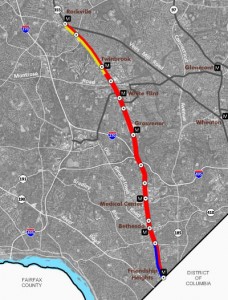Montgomery County lawmakers are considering plans for an 80-mile express bus network that is raising a divisive issue: how many car lanes should be turned into bus-only lanes?
About 80 percent of the lanes in the proposed bus rapid transit—or BRT—network would be new lanes, adding capacity to the existing corridors. About 20 percent would be “repurposed.” That’s the technical term for changing a lane now used by all traffic into “bus-only.” And AAA-MidAtlantic is asking Montgomery County to scrap that plan.
“The last thing we need to be doing is taking capacity away from traffic,” says AAA spokesman Lon Anderson. He says studies show “repurposing” lanes for buses makes traffic worse, and he calls the BRT plan lawmakers are now considering a recipe for gridlock.
Supporters say Anderson is cherry-picking his studies. Kelly Blynn at the Coalition for Smarter Growth—a major proponent of the BRT plan—says many studies have shown taking away lanes from cars actually reduces congestion.
The planning department actually hasn’t looked at each corridor yet to determine how things will change precisely because they are still at this 30,000-foot planning level. But when they ran their modeling with this proposed network, overall traffic congestion went down and traffic speeds went up.
How many lanes to “repurpose” is one of the most controversial aspects on the county’s plan, along with the potential cost and effectiveness.
Anderson says a study by the Institute for Transportation and Development Policy found only two corridors in Montgomery County currently have enough population density to support BRT.
“Those two corridors are Route 355 and I-270. ITDP indicated the other proposed routes in the county did not have sufficient density to make it work. Therefore, if you don’t have enough people to ride it, you’ll be spending a lot of money and taking lanes away from general purpose traffic, and you will wind up with worse traffic.”
The Coalition’s Blynn says projected job and population growth will provide plenty of future BRT riders.
“A lot of the places around the United States that have successful BRT systems have very similar densities to Montgomery County. Already a lot of the bus lines in the county have higher ridership than some of the successful BRT lines in places like Cleveland and Eugene, Oregon,” she says.
The ITDP study is great in many ways, but it didn’t do any modeling into the future. It looked at current bus ridership. It did not forecast out what things will look like in 2040, which the Montgomery County planning department has done.”


